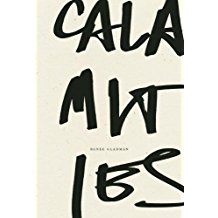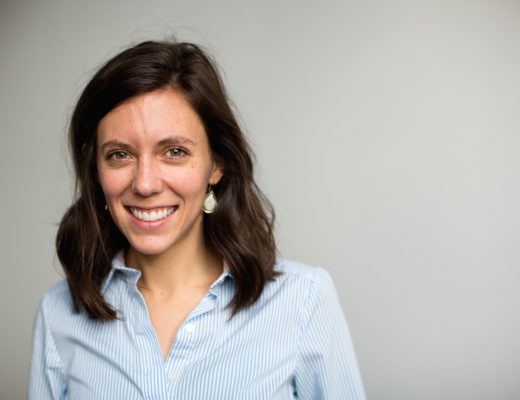Calamities
Wave Books, 126 pages, $18
Prose Architectures
Wave Books, 144 pages, $50
Renee Gladman
Prose as a Naked Language
 I began reading Renee Gladman’s Calamities on an early morning Southwest flight from Chicago to Washington D.C. in February 2017. It was for an assignment, of course, and I was on my way to a writers’ conference, hoping to get the minimum of work done before being thrust into the fray of writers, books, and alcohol. Immediately, I was underlining sentences, not because I fully understood them, but because I was fascinated with the work they were doing on a syntactic level, the way Gladman’s sentences ebbed and flowed forever, the way a paragraph could continue along for a page without exhausting itself. Calamities is an exploration of the intersections of humanity and language through essaying in its rawest form. Throughout the 126 pages of short essays, Gladman pulls readers into her thinking, forcing them to contemplate the same questions she asks of herself, and confiding in them with moments of insecurity, creative process, personal relationships, and teaching.
I began reading Renee Gladman’s Calamities on an early morning Southwest flight from Chicago to Washington D.C. in February 2017. It was for an assignment, of course, and I was on my way to a writers’ conference, hoping to get the minimum of work done before being thrust into the fray of writers, books, and alcohol. Immediately, I was underlining sentences, not because I fully understood them, but because I was fascinated with the work they were doing on a syntactic level, the way Gladman’s sentences ebbed and flowed forever, the way a paragraph could continue along for a page without exhausting itself. Calamities is an exploration of the intersections of humanity and language through essaying in its rawest form. Throughout the 126 pages of short essays, Gladman pulls readers into her thinking, forcing them to contemplate the same questions she asks of herself, and confiding in them with moments of insecurity, creative process, personal relationships, and teaching.
The essays in Calamities begin with “I began the day . . .” And while readers cannot know if Gladman is writing in the present-moment or later, each essay captivates with an introspective look at the ways language relates to every miniscule facet of her like. “I began the day looking into the infinity of the revision of my novel in progress,” Gladman begins. Another time, “I began the day in an embrace.” Later, “I began the day wanting these essays to do more than they were currently doing and even had a book alongside that I thought would help me, but it turned out I wanted more from this book as well.” Gladman’s introductions create a structure for her book, becoming the way of knowing when one essay ends and another begins.
The book is complicated in its language, but casual in its tone. Gladman doesn’t bolster her thoughts, instead remaining vulnerable and complicated on the page, never truly answering her own questions. At one point, Gladman asks why “the person in the world” (presumed to be one of her eleven shy female students) would study English: “What was she doing in a field that really left a person nowhere to go but further into herself?” While Gladman asks this of someone else, it’s interesting because she is an author, so one might assume that she’s also asking the same question of herself. Even so, Calamities may be Gladman’s answer to her own buried question, investigating language through language and contemplating what it means to be a contemporary black woman writer (among other facets of her identity). In this way, part of the calamity is intersectionality. I read along as Gladman balances being a middle-aged black woman, a lesbian, a fiction writer, an essayist, a professor, and a citizen simultaneously. The book is very human, being that it asks of the reader the same things Gladman asks of herself, but neither one has to act upon the answers. Throughout Calamities, Gladman is doing exactly what she asks of “the person in the world,” exploring further into herself not only in the existing prose, but also in the writing on the walls, walks through the city, her fiction series Houses of Ravicka, relationships, lesson plans, drawings, and more.
I was the only black person in my class, and one of the few—if not the only—students who enjoyed reading Calamities. It was in my top three books that we read in the class, but no one else was awed and inspired by Gladman’s longwinded sentences like I was, they had not sat in an airport for four hours waiting to get on a plane with only Calamities in my backpack. But I had, with pen in hand, reading and rereading complicated sentences and paragraphs. I was determined to finish Gladman before I returned to Chicago; I was determined to learn what exactly was the calamity.
The calamity is this: too many things are happening at the present moment to be contained to the same moment. I was reading Calamities, thinking about it, underlining in it, thinking about my own work, waiting for my plane, watching my suitcases, watching people, and ordering food. I was discussing Gladman, defending her work, listening to others’ opinions, asking them why/why not, taking notes, and throwing a side eye every now and then. This convergence of time, space and language is a common theme within Calamities, which often alludes to the theme and existence of Gladman’s following book of “prose,” Prose Architectures (also published by Wave Books). Throughout Calamities, Gladman’s thinking considers different potential forms of language: the sentence as architecture, the page as a space, or drawing as a form of true writing. From the beginning of the book, Gladman writes about misspeaking during a teaching lesson: “‘In any case, one can see the city— ’” I was interrupted before I could replace the errant word . . . ‘I mean, the sentence!’” This is the first reference to prose as architecture in a literal sense, showing the thinking that Gladman was doing bleeding into other work.
Prose Architectures should be paired with another Gladman work, such as Calamities, or read without the intent of truly understanding the language in which Gladman is drawing, but instead interpreting the cityscapes and maps she creates for oneself. Gladman’s drawings and the shapes she creates bloom from her environment, she describes it as drawing “the matter that was most central to [her] thinking and living, and that was the city.” Looking closely, one can see that the shapes are created using a form of asemic writing—a wordless form of writing left for readers to interpret. At first, I was afraid of Prose Architectures. It seemed like it would be the book that invalidated me as a reader and writer, a book that would ruin me if I didn’t find any meaning in it. And then months later, after meeting and talking with Gladman herself, after Gladman drew a personal prose architecture in my copy of Calamities, I decided I would try to read Prose Architectures, I would make it mean something to me.
I read Prose Architectures while re-reading Calamities. Using a different ink color, I pored through Calamities underlining new and previously underlined sentences, marking moments in the “I began the day” essays that seemed to point at Prose Architectures, asemic writing and drawing maps to get to the root of language and syntax. They were everywhere. Gladman makes constant references in Calamities to the function of time and space in writing, and the dimensions of the page when considering those narrative criteria. Gladman as a character, moves from writing on the page to writing on walls to not writing as all to drawing. These movements parallel Prose Architectures as her drawings begin as line drawings without distinctive shapes and evolve into detailed cityscapes and city grids, with smokestacks flowing from buildings, bridges. Some of her drawings include various shading, others include use of watercolors in yellow, blue, and gray—the textures and materials Gladman used in the 107 drawings depicted in the book are explained in the introduction.
I saw Renee Gladman read Calamities in Chicago in May 2017. I trekked down to University of Chicago’s campus with one of my cohort members, and we slinked into a science lecture hall, which quickly filled with a decent crowd. Physically, Calamities is made up of single paragraph essays and long, complicated sentences—the type of sentences read in a single breath if you’re trying to emulate the vibe of the writing. And this is how Gladman read, fast-paced, barely taking a breath or pause for effect, simply flowing. The most interesting part about her reading was what readers picked up on, many listeners asked Gladman questions about a seven-minute essay she read, focusing on a mushroom, which I had completely missed, wrapped up in the bigger picture of her forest walk than the minor details. At one point, Gladman picked up a piece of chalk and drew a prose architecture beneath a science equation on the board: her lines were very light and simple, and she never removed the chalk while drawing on the board. She turned back to face us and said something along the lines of, this is how she thinks, this is how she sees language.
Gladman’s work rejects the expectations of narrative and language. In both Calamities and Prose Architectures language is considered a mathematical and physical equation and one must look at the way it functions in different dimensions and on various planes of time and space. Eventually, I believe Gladman hopes a reader will be able to “read” Prose Architectures and make meaning of it. As she explained her drawings to others, “This is language with its skin pulled back.”
Negesti Kaudo is a graduate student in the English-Creative Writing Department of Columbia College Chicago.

